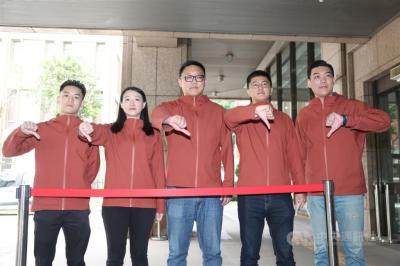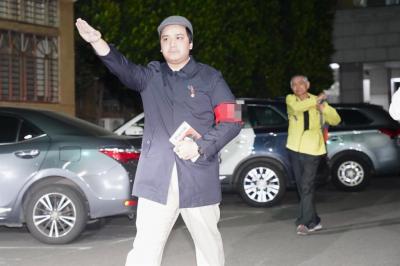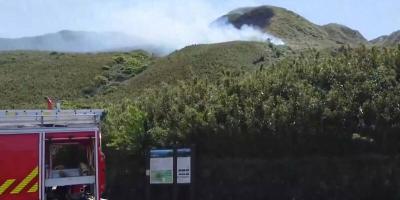The Sakizaya people officially filed their registration application to the Council of Indigenous Peoples yesterday, hoping to become Taiwan's 13th official indigenous tribe.
"According to how we handled this kind of application before, historians will analyze their [Sakizaya people] language, history and the locations where they are residing now, before we approve their application," said Walis Pelin (瓦歷斯貝林), council chairman.
According to the council, Sakizaya tribe chief Hsu Cheng-wan (徐成丸) led a group of 100 Sakizaya people from Hualien county early yesterday morning and arrived at the council in the afternoon to deliver their application in person.
The Sakizaya people hoped to officially register as the 13th indigenous tribe in Taiwan.
The other 12 tribes are Saisiyat, Thao, Tsou, Rukai, Paiwan, Tao, Puyuma, Bunun, Amis, Atayal, Kavalan and Truko.
According to Hsu, currently, the "Sakizaya" people are classified as a part of the Amis tribe. But, the Sakizaya language and Amis language are two totally different languages, and both have individual historical backgrounds as well.
In 1878, when Taiwan was under the rule of the Qing Dynasty, Sakizaya people were slaughtered by Qing troops, so most Sakizaya people tried to escape from the Qing soldiers' pursuit by changing their names and they have hidden themselves among the Amis tribe ever since. Up until today, most Sakizaya people can speak Amis language fluently, since the two tribes have been merged for more than a century.
After the Chinese Nationalist Party (KMT) government recovered Taiwan from the Japanese in 1945, the Sakizaya have never been "independent," and have always been regarded as a part of the Amis since there were more Amis people than Sakizaya people.
"But, we are still so different in many ways, in terms of language, culture, ways of living, etc.," Hsu said. "Taiwan's indigenous tribes are all unique minorities in this country, but we are all the original residents of the island. Every tribe is special and so are we."
"For instance, we call clothes zigut but Amis people call them zui. We call a cow an but Amis people call it lalaba." Hsu said that Sakizaya people are grateful for the Amis' help over the past century and they will still appreciate it in the future.

Taiwan is stepping up plans to create self-sufficient supply chains for combat drones and increase foreign orders from the US to counter China’s numerical superiority, a defense official said on Saturday. Commenting on condition of anonymity, the official said the nation’s armed forces are in agreement with US Admiral Samuel Paparo’s assessment that Taiwan’s military must be prepared to turn the nation’s waters into a “hellscape” for the Chinese People’s Liberation Army (PLA). Paparo, the commander of the US Indo-Pacific Command, reiterated the concept during a Congressional hearing in Washington on Wednesday. He first coined the term in a security conference last

Prosecutors today declined to say who was questioned regarding alleged forgery on petitions to recall Democratic Progressive Party (DPP) legislators, after Chinese-language media earlier reported that members of the Chinese Nationalist Party (KMT) Youth League were brought in for questioning. The Ministry of Justice Investigation Bureau confirmed that two people had been questioned, but did not disclose any further information about the ongoing investigation. KMT Youth League members Lee Hsiao-liang (李孝亮) and Liu Szu-yin (劉思吟) — who are leading the effort to recall DPP caucus chief executive Rosalia Wu (吳思瑤) and Legislator Wu Pei-yi (吳沛憶) — both posted on Facebook saying: “I

Sung Chien-liang (宋建樑), who led efforts to recall Democratic Progressive Party (DPP) Legislator Lee Kun-cheng (李坤城), was released on bail of NT$80,000 today amid outcry over his decision to wear a Nazi armband to questioning the night before. Sung arrived at the New Taipei District Prosecutors’ Office for questioning in a recall petition forgery case last night wearing a red armband bearing a swastika, carrying a copy of Adolf Hitler’s Mein Kampf and giving a Nazi salute. Sung left the building at 1:15am without the armband and covering the book with his coat. Lee said today that this is a serious

Firefighters are working to put out a fire on Taipei’s Yangmingshan (陽明山) reported earlier this morning. The cause of the fire is still under investigation. The Taipei Fire Department said it received a report of a fire at Xiaoyoukeng (小油坑) at 11:17am, dispatching four command vehicles, 16 firetrucks, one ambulance and 72 personnel. The fire is still burning on about 250m² of land, according to initial estimates, as eyewitnesses reported seeing smoke rising from the mountain. The Yangmingshan National Park Headquarters on Facebook said the Qixingshan (七星山) hiking trail starting from Xiaoyoukeng and the Xiaoyoukeng parking lot are closed as firefighters work to put